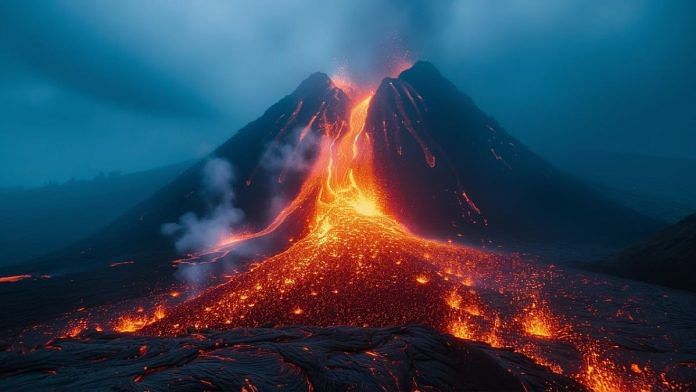New Delhi: Ancient volcanoes spewing lava could have helped inject much-needed doses of oxygen into the atmosphere billions of years ago. This set the stage for life, scientists from the University of Tokyo’s Department of Earth and Planetary Science have found.
Previous studies primarily relied on the Great Oxidation Event, during which the Earth’s atmosphere and shallow seas experienced a rise in the concentration of free oxygen for the first time, and which occurred around 2.5 billion years ago. This event marks a significant point in Earth’s history when oxygen produced by cyanobacteria through photosynthesis began accumulating in the atmosphere, leading to a sharp rise in atmospheric oxygen levels.
However, the researchers suggest that this major event may have been preceded by smaller waves of oxygen release. These releases were unsteady and unreliable, and have been referred to as “whiffs” by the researchers.
The new study, published Monday in the journal Communications Earth & Environment, by researchers from the University of Tokyo, suggests that massive geological events like the growth of continents and strong volcanic activity may have warmed the planet and added essential nutrients to the oceans, creating favourable conditions for microorganisms to thrive. Over time, photosynthesis by these microorganisms increased the rate at which carbon dioxide was converted into oxygen, leading to the buildup of an oxygen-rich atmosphere.
“Activity of microorganisms in the ocean played a central role in the evolution of atmospheric oxygen. However, we think this would not have immediately led to atmospheric oxygenation because the amount of nutrients in the ocean was limited, restricting the activity of cyanobacteria, capable of photosynthesis,” said co-author of the study, Professor Eiichi Tajika from the Department of Earth and Planetary Science at the University of Tokyo, in a statement.
Also Read: Posture panic hits researchers. IITs, AIIMS, big hospitals use smart microscopes now
Understanding early oxygenation
In the study, the researchers used numerical models to simulate important biological, geological, and chemical changes that occurred during the late Archean Eon, which lasted between four and 2.5 billion years ago. This was the period when the Earth’s crust formed and life first appeared. These simulations help in understanding the complex processes that led to major shifts in Earth’s early environment.
While traces of oxygen were present on the Earth even before the Great Oxidation Event, their levels were very low during this time. Chemical evidence shows there were brief periods when oxygen temporarily appeared in the atmosphere and oceans.
For instance, while studying the Mount McRae Shale in Western Australia, researchers discovered high concentrations of elements such as molybdenum (Mo) and rhenium (Re). These elements are released from continental rocks only in the presence of oxygen, indicating that there was a short-lived increase in atmospheric oxygen even before the Great Oxidation Event.
The study suggests that these “whiffs” of oxygen were triggered by an increase in phosphorus levels, a key element required by organisms to carry out photosynthesis. This increase in phosphorus was due to volcanic eruptions, which released large amounts of carbon dioxide, enhancing the weathering process and nutrient runoff into the oceans, thereby boosting microbial life and oxygen production.
“Our model also indicated that a higher fraction of continental area increases the susceptibility of the system to a whiff by increasing the phosphorus supply rate,” the researchers wrote in the study, highlighting the role of the continental crust in enhancing oxygen in the atmosphere. These periodic oxygen increases played a crucial role in helping early life forms adapt to oxygen, laying the foundation for the Great Oxidation Event.
The authors suggest that further research into the Earth’s atmosphere, life, and geological processes that occurred during this period can improve our understanding of the evolution of life and the planet.
Such studies reveal that life’s emergence is not a cosmic accident but a natural consequence of the right conditions, the statement says.
Sneha Yadav graduated from the first batch of ThePrint School of Journalism.
(Edited by Radifah Kabir)
Also Read: Search for an Indian Carl Sagan is on. Science influencers are being trained in labs and likes






